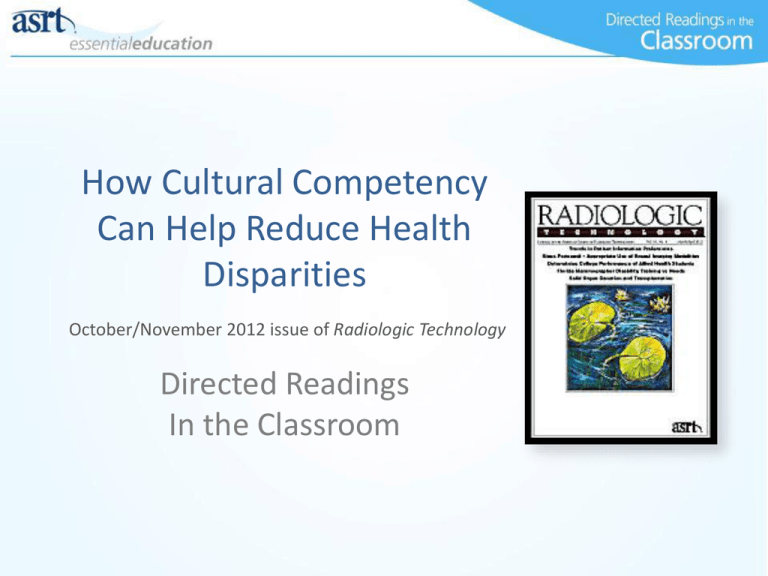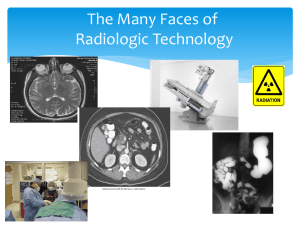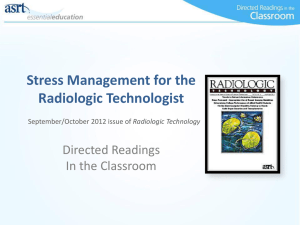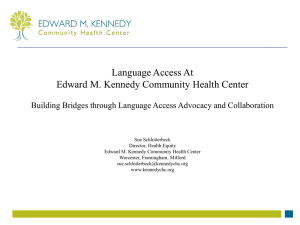Cultural Competency - American Society of Radiologic Technologists
advertisement

How Cultural Competency Can Help Reduce Health Disparities October/November 2012 issue of Radiologic Technology Directed Readings In the Classroom Instructions: This presentation provides a framework for educators and students to use Directed Reading content published in Radiologic Technology. This information should be modified to: 1. Meet the educational level of the audience. 2. Highlight the points in an instructor’s discussion or presentation. The images are provided to enhance the learning experience and should not be reproduced for other purposes. Introduction Radiologic technologists encounter patients from a variety of racial, ethnic, and socioeconomic backgrounds. Reduced income and access to health care among minority and immigrant populations accounts for many health disparities. Enhancing cultural competency among health care providers and providing culturally appropriate services can improve communication, access to health care, and eventually health outcomes. Although awareness of a patient’s ethnic or racial background can aid in screening and diagnosis, patient-centered care requires that everyone be seen as individuals first and members of a racial or ethnic minority second. Health Disparities Health disparities are generally understood to be differences in the incidence and prevalence of disease and adverse health conditions among specific populations when compared to the national average or to another index group. Commonly cited health disparities in the United States include differences in the rate of infant mortality, cancer screening and management, cardiovascular disease, diabetes, and HIV infection/AIDS between the majority white population and various minority racial or ethnic groups. Health Disparities Health disparities exact individual and societal costs. Individuals are more likely to experience reduced quality of life, illness, or death. For society, health disparities result in reduced work productivity, lost economic opportunity, and increased costs for publicly funded health programs and private health insurance. Health disparities also adversely affect family members who must deal with potential economic hardships following the death or serious illness of a loved one. Ripple effects such as these are greatest within minority and immigrant communities where health disparities go unaddressed. Cultural Competency The term “culture” refers to a collective programming of the mind that distinguishes members of a group from those of another group. A culture encompasses the knowledge, experience, beliefs, values, attitudes, worldview, and family and gender roles acquired by a relatively large group of people in the course of generations. Health Care Cultural Competency In health care, “cultural competency” refers to behaviors, attitudes, and policies that consistently guide health care systems, agencies, and personnel and enable them to work effectively in cross-cultural situations. It also has been defined as the ability of health care providers and systems to care for patients with diverse values, beliefs, and behaviors in a manner that meets their social, cultural, and linguistic needs. The ultimate goal of cultural competency is a health care system and workforce that delivers the highest quality care to every patient — regardless of race, ethnicity, cultural background, or language proficiency. Health Care Cultural Competency Cultural competency shares many features with the concept of patient-centered care, including: • • • • • • Recognizing the personal uniqueness of the patient. Exploring and respecting patient beliefs, values, preferences, and needs. Maintaining awareness of one’s automatic assumptions and biases. Providing patient information and education tailored to the individual’s level of understanding. Cultivating good communication skills and using medical interpreters when necessary. Actively encouraging patients to participate in the decisionmaking process as it relates to individual health needs. Culture’s Influence Cultural background influences how we: • • • Understand the concepts of health and illness. Express pain and discomfort. Seek help for our symptoms or distress. Subtle cultural influences may be difficult for a casual observer to identify. Although some examples discuss particular ethnic groups or nationalities, they are intended to encourage radiologic technologists to think about cultural influences in general. In addition, not every patient of a particular ethnicity or nationality exhibit the behaviors or attitudes described. Help-seeking Behavior Our cultural backgrounds also may influence how intensely we experience illness, what type of treatment we seek, and how we respond to that treatment. Such tendencies and cultural influences may be passed from 1 generation to another through parental modeling. On 1 extreme, some parents may have modeled an excessive response to illness that borders on hypochondria; on the other extreme, some parents may have modeled an inadequate response to symptoms or deny the illness entirely. Help-seeking Behavior The health care system in a patient’s original homeland also may influence how he or she seeks care and responds to health care professionals in the United States. For example, if relatively mild illnesses such as coughs, diarrhea, or stomachaches were addressed with herbal medicines, the practice is likely to continue while living in the United States. Biomedical care may be sought only for more serious or worsening conditions. Role of Family Members Radiologic technologists and other health care professionals may be confused or surprised by how involved some family members of patients are. In many cultures, multiple family members commonly accompany patients to medical appointments or remain with them throughout a hospital stay. This is especially common with a woman or child patient. When staying overnight is impractical or impossible, multiple family members may visit daily to show concern and to address their own or the patient’s worries. If a nursing shortage existed in the patient’s original homeland, family members may be accustomed to handling basic care such as hygiene or feeding. Using Medical Interpreters Preferred language may be the most obvious cultural difference a radiologic technologist encounters when practicing in an ethnically diverse service area. Language barriers could compromise quality of care and patient safety. When a patient’s first language is not English or when a patient has limited English proficiency (LEP), a specially trained medical interpreter may be necessary. Although the definition of LEP is self-determined, typically a patient who describes himself or herself as speaking English less than “very well” is considered an LEP patient. Using Medical Interpreters The Civil Rights Act of 1964, which prohibits discrimination on the basis of race, color, and national origin, requires health care organizations and providers who receive federal funding to make interpreter services available to patients who have limited proficiency in English. If interpreters are not provided to patients with limited proficiency, health care providers and organizations risk a discrimination claim. The importance of full and accurate communication is reflected in the U.S. Department of Health and Human Services’ Culturally and Linguistically Appropriate Services (CLAS) standards, where standards 4 through 7 relate to providing interpreter services or patient education materials in appropriate languages. Interpreter Service A formal plan for ensuring that interpreter services are provided in a timely and reliable fashion will help medical imaging facilities meet their ethical and legal obligations to LEP patients and their families. Interpreter Service For the Examination Radiologic technologists who use trained medical interpreters should: • Allow sufficient time for the imaging session – using an interpreter can increase the time needed to complete the imaging procedure. • Meet briefly with the interpreter before the examination – review basic information about the patient, the reason for the procedure, the steps needed to complete it, and any necessary documents. Decide where the interpreter will sit or stand in the room and inform the interpreter if lead aprons or other protective measures will be used. For the Examination • View the interpreter as an ally who can help facilitate successful completion of the procedure – he or she is a cultural, as well as linguistic, interpreter who can point out culturally appropriate social interactions with the patient. Maintain eye contact with the patient, not with the interpreter – regardless of language barriers, address comments to the patient, not to the interpreter. To facilitate eye contact, place the interpreter slightly to the side of or behind the patient. This positioning also will allow the interpreter to observe the patient’s body language and mannerisms. • Ensure valuable information is not lost – pause when necessary to allow for sufficient and timely interpretation; speak slowly and clearly in short sentences. For the Examination • Avoid jargon and technical terms – use plain language and strive for clarity and simplicity. If the interpreter does not understand a phrase or term used, reword the comment or question, rather than repeat it. • Watch for cues – when positioning a patient for an imaging procedure, observe his or her posture, gestures, and facial expression for valuable clues regarding pain, confusion, or discomfort. • After the imaging session, speak with the interpreter alone – ask for his or her feedback regarding the imaging session or the patient. Types of Interpreters • Telephone Interpreter Services - When in-person interpretation is not available, health care providers may use a telephone interpreter service that offers many languages. • Video Conferencing - This increasingly available and often preferred technology provides a video image of the medical interpreter who, in turn, also can see and hear the patient and others in the room. • Voice-activated Software - Some voice-activated computer software can recognize speech in 1 language and translate it into another. • Family or Friends - Standard 6 of the CLAS standards discourages the use of a patient’s family members or personal friends for language interpretation, unless specifically requested by the patient. Family or Friends Radiologic technologists who do use a patient’s family member or friend for language interpretation should: • Gauge the interpreter’s level of English proficiency. • Remind the interpreter to interpret everything accurately and completely. Ask him or her not to paraphrase statements or to answer questions on behalf of the patient. • Tell the interpreter to let the technologist know if he or she is speaking too quickly or if he or she must repeat something. • Interact frequently with the patient and ask the patient to repeat what was just said to make sure he or she understands. • If the interpreter and patient begin engaging in a side conversation, interrupt and ask the interpreter to explain everything that is being said. Organizational Cultural Competency A health care facility reflects organizational cultural competency when its policies, practices, and structures enhance work efficiency in cross-cultural situations. The Hospital for Sick Children demonstrated its commitment to organizational cultural competency by developing diversity initiatives, instituting policy and program changes, and encouraging a work environment conducive to further education in cultural diversity. The hospital used external grant funding to establish a new immigrant support network. This centralized network’s sole purpose was to devote time, resources, and expertise to the hospital’s efforts at improving cultural competency. In addition to providing cultural competency training to hospital staff, the network arranged the translation of patient education materials into 9 different languages. Structural Cultural Competency An organization reflects structural cultural competency when its systems and processes enhance its capacity to function in a culturally competent manner. The Hospital for Sick Children used its cultural competency initiative to implement 2 key projects that could create a more culturally responsive environment. First, it placed 12 new informational kiosks around the hospital. These offered information in multiple languages to help guide patients and their families around the facility. Next, the hospital translated its patient satisfaction survey into 7 languages, thereby increasing the number of families who could complete it. Clinical Cultural Competency An organization reflects structural cultural competency when its systems and processes enhance its capacity to function in a culturally competent manner. The Hospital for Sick Children used its cultural competency initiative to implement 2 key projects that could create a more culturally responsive environment. First, it placed 12 new informational kiosks around the hospital. These offered information in multiple languages to help guide patients and their families around the facility. Next, the hospital translated its patient satisfaction survey into 7 languages, thereby increasing the number of families who could complete it. Clinical Cultural Competency An organization reflects clinical cultural competency when it educates its workforce about cultural differences and influences they are likely to encounter. Promoting Cultural Competency Among Individuals Reflecting on one’s own attitudes, behaviors, and belief systems is essential to providing culturally competent care. Radiologic technologists can engage with patients more effectively when they examine how their own beliefs and values might influence their behavior and care of patients. Becoming aware of personal stereotypes is the first step in replacing one’s biases with evidence-based, accurate knowledge about the social and cultural background of patients, their families, and their environments. Having accurate evidence-based knowledge can conquer conscious bias. Unconscious bias, which may be more difficult to overcome, also can influence individual encounters with patients. Countering Unconscious Bias Although identifying the needs of minority patients is integral to practicing cultural competency, automatically categorizing an individual as a member of any socioeconomic, racial, or ethnic group can trigger unconscious stereotypes and prejudices. Even if the radiologic technologist consciously rejects the stereotypes or prejudices, these unconscious biases may subtly affect how the technologist interacts with minority group patients. If a patient perceives a bias, however subtle, he or she may become uncomfortable and reluctant to return for follow-up imaging or subsequent care at the clinic or facility. Such reluctance on the patient’s part can perpetuate health disparities. Countering Unconscious Bias To avoid triggering unconscious bias, experts in cultural competency suggest to: • Begin the patient encounter by looking for similarities rather than differences between yourself and the patient. • Establish a common identity. For example, each of you may be a parent to a child or a caregiver to an elderly parent. Both of you may be women or men. You may share a hobby or a mutual interest. Such common identities help counter unconscious stereotypes, and help you understand the day-to-day world and life issues of the minority group patient — a perspective that can reinforce your patient-centered care. Countering Unconscious Bias • Refrain from categorizing the patient’s racial or ethnic identity until it becomes useful for making appropriate medical decisions. • Take the perspective of the patient. Imagining the difficult situation faced by racial minorities and stigmatized ethnic groups helps decrease the activation of even unconscious stereotypes. Such a perspective also provides an opportunity for radiologic technologists to exercise the humanistic beliefs and values that originally led them to a medical profession and patient care. Hiring a Diverse Workforce Recruiting and retaining radiologic technologists who share the life experiences of their minority and disadvantaged patients can help address health disparities and improve patient care outcomes. Shared life experiences allow radiologic technologists more familiar with the patient’s culture to facilitate better communication with the patient and help establish a more effective health care partnership between the patient and members of the medical team. More effective communication can help improve patient compliance with care and reduce negative health outcomes. A diverse workforce begins with a diverse student body in medical and allied health education programs. Radiologic Technologist Programs Some of these same methods of minority student recruitment and retention may be appropriate for radiologic technology education programs. Radiologic technologists constitute 1 of the least culturally diverse workforces among health care professionals. Out of 20 radiologic technologists, only 3 are likely to be a race or ethnicity other than white. Several factors are thought to contribute to this ratio. First, most students who enter radiologic technology training programs became familiar with the field after experiencing the benefits of diagnostic imaging as a patient or patient’s family member. Radiologic Technologist Programs To recruit more students, radiologic technology educators can: • Attend high school career fairs. • Visit community colleges to speak to advisors and potential students. • Reach out to churches and other civic groups active with young people. • Educate career counselors in high schools and colleges on the rewards and challenges of work in diagnostic imaging, radiation therapy, and related fields. • Arrange for job-shadowing opportunities where students can witness challenges and rewards first-hand. Radiologic Technologist Programs With so many allied health career choices available, it may help to remind potential students that: • Quality diagnostic imaging contributes significantly to accurate medical diagnosis and appropriate care. • Imaging procedures continually draw on the latest advances in computer technology and medical innovation. • Every day on the job is different from the 1 before. • Radiologic technology careers encompass a variety of imaging and therapeutic modalities. Radiologic Technologist Programs With so many allied health career choices available, it may help to remind potential students that: • Quality diagnostic imaging contributes significantly to accurate medical diagnosis and appropriate care. • Imaging procedures continually draw on the latest advances in computer technology and medical innovation. • Every day on the job is different from the 1 before. • Radiologic technology careers encompass a variety of imaging and therapeutic modalities. Common Health Disparities in Radiologic Technology Radiographers who work in large clinics or health care facilities are likely to witness the effects of health disparities firsthand, including patients who postponed care until symptoms became unmanageable or an emergency arose. All radiologic technologists also may witness the gradual progression of disease that has not been adequately managed. Among the most commonly cited health disparities, those related to breast cancer and cardiovascular disease offer the best examples of how radiologic technologists— particularly those who specialize in mammography or cardiovascularinterventional technology— might encounter the effects of health disparities in their everyday work. Mammography and Breast Cancer Screening Although mammography effectively reduces deaths from breast cancer, medically underserved women may postpone mammography services or never receive them at all, which can delay critical diagnoses and lifesaving treatments. Medically underserved women are therefore more likely to die from breast cancer than are other women. Cultural competency initiatives that can increase access to care and reduce this disparity are likely to be of interest to radiologic technologists who provide mammography services. Cardiovascular Disease Screening and Management Among the most commonly cited health disparities are those related to cardiovascular disease. A disproportionate share of the mortality from heart disease and stroke in the United States is borne by African Americans. At any given age, they are 2 to 3 times more likely to die from heart disease than members of the white population. Rates of hypertension in African Americans are among the highest in the world and are increasing. The high prevalence of hypertension among African Americans is not itself a health disparity, but becomes one when measures to manage and treat it are less available to racial minorities and economically depressed populations. Cardiovascular Disease Screening and Management Hispanic Americans experience heart failure at younger ages than the white population, have higher hospital readmission rates, and encounter numerous barriers to care because of language, socioeconomic, and cultural factors. This lack of access to care and intervention translates into poorer outcomes and notable health disparities. One factor with a disproportionate effect on access to care is the understanding — real or perceived — that patients from minority racial and ethnic backgrounds have regarding the larger society, in particular the medical system. Cardiovascular Disease Screening and Management Societal and institutional barriers affect health disparity, but individual providers also may perpetuate issues through language barriers, cultural insensitivity, unconscious or conscious bias, and even outright racism. Patient issues such as health literacy, cultural beliefs, lack of adherence to treatment plans, and mistrust of individual providers also perpetuate health disparities. Training health care providers in cultural competency and educating and supporting patients are essential to addressing health disparity. Conclusion Cultural competency has the potential to increase trust and subsequently improve adherence to health care recommendations and treatment plans. When a health care professional is culturally competent, patients are more likely to feel accepted, recognized, and empowered to participate fully in their own disease prevention, management, and healing regardless of cultural or ethnic background, religion, or linguistic proficiency. Discussion Questions Thinking about unconscious bias, what are some ways Radiologic Technologists can prevent this. Discuss why standard 6 of the CLAS standards discourages the use of a patient’s family members or personal friends for language interpretation. Discuss how increasing cultural competency can decrease health care disparities. Additional Resources Visit www.asrt.org/students to find information and resources that will be valuable in your radiologic technology education.









